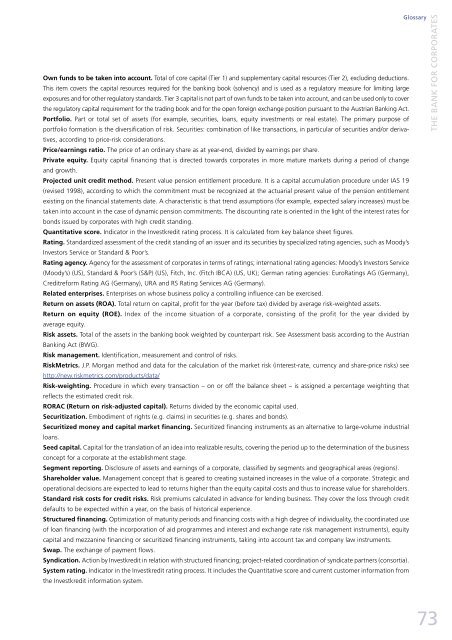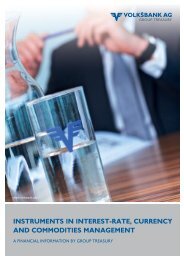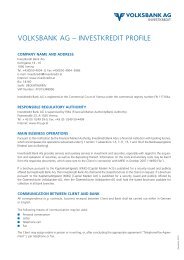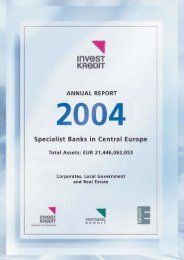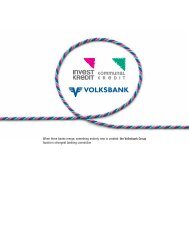Download - Volksbank AG
Download - Volksbank AG
Download - Volksbank AG
You also want an ePaper? Increase the reach of your titles
YUMPU automatically turns print PDFs into web optimized ePapers that Google loves.
Own funds to be taken into account. Total of core capital (Tier 1) and supplementary capital resources (Tier 2), excluding deductions.<br />
This item covers the capital resources required for the banking book (solvency) and is used as a regulatory measure for limiting large<br />
exposures and for other regulatory standards. Tier 3 capital is not part of own funds to be taken into account, and can be used only to cover<br />
the regulatory capital requirement for the trading book and for the open foreign exchange position pursuant to the Austrian Banking Act.<br />
Portfolio. Part or total set of assets (for example, securities, loans, equity investments or real estate). The primary purpose of<br />
portfolio formation is the diversification of risk. Securities: combination of like transactions, in particular of securities and/or derivatives,<br />
according to price-risk considerations.<br />
Price/earnings ratio. The price of an ordinary share as at year-end, divided by earnings per share.<br />
Private equity. Equity capital financing that is directed towards corporates in more mature markets during a period of change<br />
and growth.<br />
Projected unit credit method. Present value pension entitlement procedure. It is a capital accumulation procedure under IAS 19<br />
(revised 1998), according to which the commitment must be recognized at the actuarial present value of the pension entitlement<br />
existing on the financial statements date. A characteristic is that trend assumptions (for example, expected salary increases) must be<br />
taken into account in the case of dynamic pension commitments. The discounting rate is oriented in the light of the interest rates for<br />
bonds issued by corporates with high credit standing.<br />
Quantitative score. Indicator in the Investkredit rating process. It is calculated from key balance sheet figures.<br />
Rating. Standardized assessment of the credit standing of an issuer and its securities by specialized rating agencies, such as Moody’s<br />
Investors Service or Standard & Poor’s.<br />
Rating agency. Agency for the assessment of corporates in terms of ratings; international rating agencies: Moody’s Investors Service<br />
(Moody’s) (US), Standard & Poor’s (S&P) (US), Fitch, Inc. (Fitch IBCA) (US, UK); German rating agencies: EuroRatings <strong>AG</strong> (Germany),<br />
Creditreform Rating <strong>AG</strong> (Germany), URA and RS Rating Services <strong>AG</strong> (Germany).<br />
Related enterprises. Enterprises on whose business policy a controlling influence can be exercised.<br />
Return on assets (ROA). Total return on capital, profit for the year (before tax) divided by average risk-weighted assets.<br />
Return on equity (ROE). Index of the income situation of a corporate, consisting of the profit for the year divided by<br />
average equity.<br />
Risk assets. Total of the assets in the banking book weighted by counterpart risk. See Assessment basis according to the Austrian<br />
Banking Act (BWG).<br />
Risk management. Identification, measurement and control of risks.<br />
RiskMetrics. J.P. Morgan method and data for the calculation of the market risk (interest-rate, currency and share-price risks) see<br />
http://new.riskmetrics.com/products/data/<br />
Risk-weighting. Procedure in which every transaction – on or off the balance sheet – is assigned a percentage weighting that<br />
reflects the estimated credit risk.<br />
RORAC (Return on risk-adjusted capital). Returns divided by the economic capital used.<br />
Securitization. Embodiment of rights (e.g. claims) in securities (e.g. shares and bonds).<br />
Securitized money and capital market financing. Securitized financing instruments as an alternative to large-volume industrial<br />
loans.<br />
Seed capital. Capital for the translation of an idea into realizable results, covering the period up to the determination of the business<br />
concept for a corporate at the establishment stage.<br />
Segment reporting. Disclosure of assets and earnings of a corporate, classified by segments and geographical areas (regions).<br />
Shareholder value. Management concept that is geared to creating sustained increases in the value of a corporate. Strategic and<br />
operational decisions are expected to lead to returns higher than the equity capital costs and thus to increase value for shareholders.<br />
Standard risk costs for credit risks. Risk premiums calculated in advance for lending business. They cover the loss through credit<br />
defaults to be expected within a year, on the basis of historical experience.<br />
Structured financing. Optimization of maturity periods and financing costs with a high degree of individuality, the coordinated use<br />
of loan financing (with the incorporation of aid programmes and interest and exchange rate risk management instruments), equity<br />
capital and mezzanine financing or securitized financing instruments, taking into account tax and company law instruments.<br />
Swap. The exchange of payment flows.<br />
Syndication. Action by Investkredit in relation with structured financing; project-related coordination of syndicate partners (consortia).<br />
System rating. Indicator in the Investkredit rating process. It includes the Quantitative score and current customer information from<br />
the Investkredit information system.<br />
Glossary<br />
THE BANK FOR CORPORATES<br />
73


